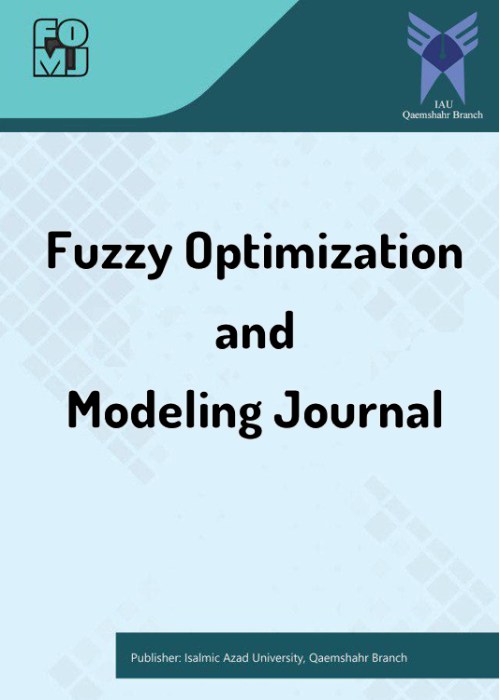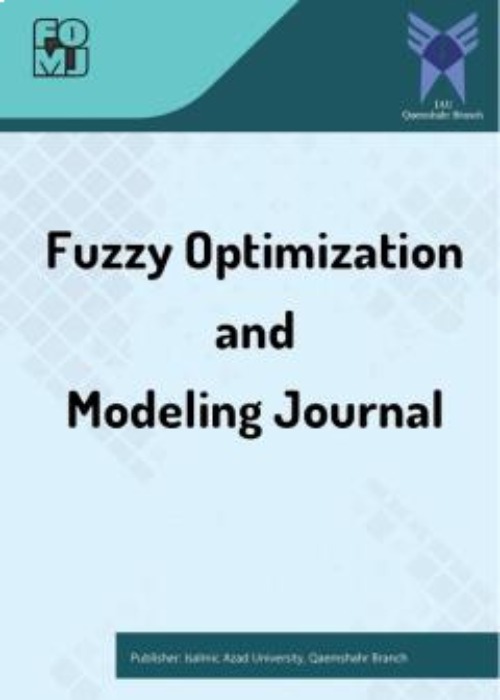فهرست مطالب

Fuzzy Optimzation and Modeling
Volume:4 Issue: 2, Spring 2023
- تاریخ انتشار: 1402/08/28
- تعداد عناوین: 6
-
-
Pages 1-12The paper proposes a procedure for solving a linear system of fuzzy differential equations from the point of view of the generalized Hukuhara derivative. First, the method is based on two functions of half-length and midpoint of fuzzy numbers and next it is implemented on the problem in two separate cases of generalized Hukuhara differentiability, in details. Two numerical examples are given to clarify the practical application of the results.Keywords: Fuzzy differential, fuzzy systems, Gh-differentiable
-
Pages 13-26In this study, a method for predicting engine torque and emissions considering fuel consumption and engine speed parameters is presented. An adaptive neuro-fuzzy inference system (ANFIS) optimized with the Firefly algorithm is used. This strategy uses the global optimization capabilities of the Firefly algorithm, an algorithm inspired by biological phenomena, in combination with the ability of ANFIS to describe complicated non-linear relationships between inputs and outputs. The ANFIS system was trained on a dataset containing various engine operating conditions, with the Firefly algorithm fine-tuning the model parameters to ensure optimal effectiveness. The input parameters of the model consisted of fuel quantity and engine speed, while engine torque and nitrogen oxide emissions formed the output parameters. The results obtained showed high accuracy in predicting engine torque and emissions, confirming the effectiveness of the Firefly-optimized ANFIS model. This model makes an important contribution to engine performance monitoring and emissions management. It provides a powerful tool for real-time regulation and has the potential to improve fuel efficiency while reducing environmental impact. Future research efforts should extend the applicability of this model to a wider range of engine shapes and operating conditions.Keywords: Firefly Algorithm, ANFIS, Engine Torque, Machine Learning, Optimization
-
Pages 27-38The AH1N1/09 influenza virus is one of the most dangerous viruses that has greatly affected human life. As it is an unstable virus and new types of it with different features are created every year, its investigation is important. Various mathematical models have been proposed to describe such diseases. In this paper, mathematical modeling in the form of fractional differential equations with the Atangana-Baleanu-Caputo (ABC) derivative and initial value is proposed to study this virus. Since the nature of the virus and how it affects the human body are ambiguous and imprecise, its fuzzy model is discussed. By using tools such as r-cut, generalized Hakuhara difference, ABC fractional derivative in fuzzy mode, and ABC-PI numerical method, the proposed model is solved numerically. At the end, a numerical example is provided to show the applicability of the method.Keywords: Atangana-Baleanu-Caputo (ABC) derivative, Fuzzy Atangana-Baleanu-Caputo Fractional Derivative, Fuzzy AH1N1, 09 Influenza Model
-
Pages 39-48In this paper, the distance between two vertices in a fuzzy graph is defined in a new way. In addition, some new degree-based fuzzy graph polynomials are introduced. By using this definition, fuzzy graph polynomials, and a special lower triangular matrix, the Wiener index and the generalized Wiener index of a fuzzy graph are computed, which coincide with the Wiener index and the generalized Wiener index in the crisp graph. The result is used to compute the Wiener index of the sum, products, and composition of two fuzzy graphs.Keywords: Fuzzy graph, Fuzzy Wiener index, Fuzzy graph degree-based polynomial
-
Pages 49-61
The location allocation problem is one of the most attractive optimization problems that is widely used in the real world. Therefore, any attempt to bring this problem closer to real-world conditions would be significant and useful. In this paper, we utilize fuzzy logic due to the uncertainty of parameters in the real world. That is the weights (the amounts of demands of customers) and variables (the coordinates of the optimal place) are both considered fuzzy numbers. If these variables are considered definitively, due to various conditions and reasons, it may not be possible to acquire land or build a facility center in it, so we also considered this variable in a fuzzy way and a facility center area was obtained, that certainly, the decision maker can find the right place more easily. To solve the fuzzy problem a new approach based on presenting the problem in the form of equivalent expressions is proposed. This equivalent problem is solved using fuzzy arithmetic.
Keywords: Single facility location problem, Demand centers, Facility centers, fuzzy numbers -
Pages 62-80
In this paper, we propose an empirical hybrid approach for measuring the performance of Islamic banks in MENA region by combination of four techniques including CAMEL, Grey Relation, fuzzy ANP, and FARAS during two three-year periods (from 2014 to 2019). Our findings that also considered as our contributions are as follows: firstly, this approach excludes indicators that overlap each other from the evaluation process (parsimony). secondly, it prevents the removal of important indicators (generosity). Thirdly, we have compared three most popular MCDM techniques and have shown which ones give us the best ranking results. Finally, we also improve the application of CAMEL model.
Keywords: Fuzzy ANP, Fuzzy VIKOR, camel, Grey Relation, Fuzzy ARAS


